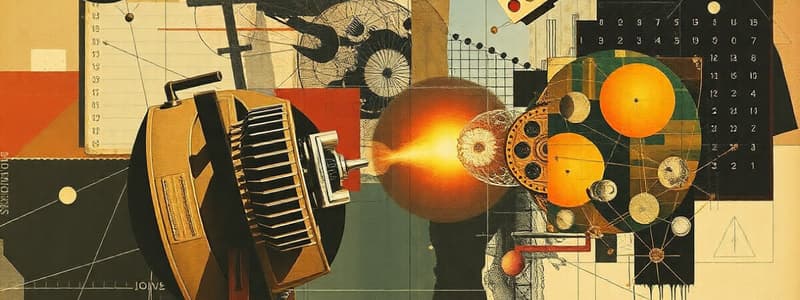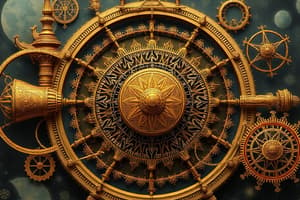Podcast
Questions and Answers
What is the key difference between quantum mechanics and special relativity?
What is the key difference between quantum mechanics and special relativity?
- Quantum mechanics describes the behavior of matter at the atomic and subatomic level, while special relativity describes space and time in relation to motion. (correct)
- Quantum mechanics focuses on the behavior of atoms, while special relativity focuses on the behavior of nuclei.
- Quantum mechanics explains phenomena like the photoelectric effect and radioactivity, while special relativity describes the curvature of spacetime.
- Quantum mechanics deals with waves and particles, while special relativity deals with the relationship between energy and mass.
Which of the following is NOT a phenomenon explained by quantum mechanics?
Which of the following is NOT a phenomenon explained by quantum mechanics?
- Atomic spectra
- Radioactivity
- The bending of light around massive objects (correct)
- The photoelectric effect
What is the primary focus of nuclear physics?
What is the primary focus of nuclear physics?
- The development of atomic models
- The structure and properties of atomic nuclei (correct)
- The behavior of electrons orbiting the nucleus
- The interaction of atoms with photons
Which of the following statements about atomic spectra is CORRECT?
Which of the following statements about atomic spectra is CORRECT?
What is a key difference between nuclear fission and nuclear fusion?
What is a key difference between nuclear fission and nuclear fusion?
According to Newton's first law of motion, what happens to an object in motion if no unbalanced force acts upon it?
According to Newton's first law of motion, what happens to an object in motion if no unbalanced force acts upon it?
Which of the following is NOT a key concept in thermodynamics?
Which of the following is NOT a key concept in thermodynamics?
The second law of thermodynamics states that the total entropy of an isolated system can only:
The second law of thermodynamics states that the total entropy of an isolated system can only:
What is the relationship between electric charges and magnetic fields?
What is the relationship between electric charges and magnetic fields?
Which of the following is NOT a key phenomenon associated with the wave nature of light?
Which of the following is NOT a key phenomenon associated with the wave nature of light?
What is the primary distinction between classical mechanics and modern physics?
What is the primary distinction between classical mechanics and modern physics?
Which of these is a key application of optics?
Which of these is a key application of optics?
What is the relationship between heat, work, and energy described by thermodynamics?
What is the relationship between heat, work, and energy described by thermodynamics?
Flashcards
Quantum Mechanics
Quantum Mechanics
The study of matter behavior at atomic and subatomic levels.
Wave-Particle Duality
Wave-Particle Duality
The concept that particles can exhibit properties of both waves and particles.
Special Relativity
Special Relativity
Theory that describes how space and time are relative and affect objects in motion.
Atomic Spectra
Atomic Spectra
Signup and view all the flashcards
Nuclear Reactions
Nuclear Reactions
Signup and view all the flashcards
Newton's First Law
Newton's First Law
Signup and view all the flashcards
Newton's Second Law
Newton's Second Law
Signup and view all the flashcards
Newton's Third Law
Newton's Third Law
Signup and view all the flashcards
First Law of Thermodynamics
First Law of Thermodynamics
Signup and view all the flashcards
Second Law of Thermodynamics
Second Law of Thermodynamics
Signup and view all the flashcards
Maxwell's Equations
Maxwell's Equations
Signup and view all the flashcards
Reflection and Refraction
Reflection and Refraction
Signup and view all the flashcards
Study Notes
Classical Mechanics
- Classical mechanics describes the motion of macroscopic objects under the influence of forces.
- It's based on Newton's laws of motion.
- Newton's first law (inertia): An object at rest stays at rest and an object in motion stays in motion with the same speed and in the same direction unless acted upon by an unbalanced force.
- Newton's second law (force and acceleration): The acceleration of an object is directly proportional to the net force acting on it and inversely proportional to its mass. F = ma.
- Newton's third law (action-reaction): For every action, there is an equal and opposite reaction.
- Classical mechanics is used to analyze the motion of planets, projectiles, and everyday objects.
- Concepts like momentum, energy, and angular momentum are central to classical mechanics.
Thermodynamics
- Thermodynamics deals with the relationship between heat, work, and energy.
- Key concepts include temperature, heat, internal energy, and entropy.
- The first law of thermodynamics: Energy cannot be created or destroyed, only transferred or changed from one form to another.
- The second law of thermodynamics: The total entropy of an isolated system can only increase over time.
- The third law of thermodynamics: The entropy of a system approaches a constant value as the temperature approaches absolute zero.
- Applications are seen in engines, refrigerators, and other heat-transfer devices.
Electromagnetism
- Electromagnetism describes the interaction between electric charges and magnetic fields.
- Electric charges exert forces on each other.
- Electric fields exist around charged objects.
- Moving charges create magnetic fields.
- Magnetic fields exert forces on moving charges.
- Maxwell's equations describe the relationship between electric and magnetic fields.
- Applications include electricity generation, radio communications, and various technologies.
Optics
- Optics deals with the behavior of light.
- Light can be described as waves.
- Reflection and refraction describe how light interacts with surfaces.
- Lenses and mirrors can focus and manipulate light.
- The nature of light depends on the situation; sometimes it acts as a wave and sometimes as a particle.
- Key phenomena include diffraction, interference, and polarization.
- Applications include telescopes, microscopes, and optical fibers.
Modern Physics
- Modern physics encompasses quantum mechanics and relativity.
- Quantum mechanics describes the behavior of matter at the atomic and subatomic level.
- Particles exhibit wave-particle duality; meaning that they act as both waves and particles.
- Quantum mechanics explains phenomena like the photoelectric effect, atomic spectra, and radioactivity.
- Special relativity describes space and time in relation to motion.
- Space and time are relative and intertwined, affecting the behavior of objects moving at high speeds.
- General relativity describes gravity as a curvature of spacetime caused by mass and energy.
Atomic Physics
- Atomic physics studies the structure and behavior of atoms.
- Electrons orbit the nucleus.
- Atomic spectra provide information about the energy levels within atoms.
- Atomic models are used to explain atomic behavior.
- Atoms interact with photons in quantized energy levels.
- The study of atoms has many applications, such as in lasers and medical imaging.
Nuclear Physics
- Nuclear physics explores the structure and properties of atomic nuclei.
- Atomic nuclei are composed of protons and neutrons.
- Nuclear forces are the forces that hold the nucleus together.
- Radioactive decay involves the release of particles and energy from unstable nuclei.
- Nuclear reactions, such fission and fusion, release massive amounts of energy.
- Applications are found in nuclear power, medical imaging, and industrial processes.
Studying That Suits You
Use AI to generate personalized quizzes and flashcards to suit your learning preferences.




